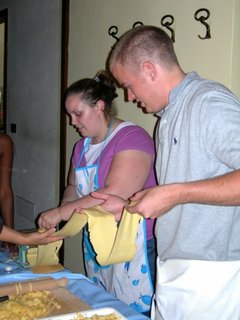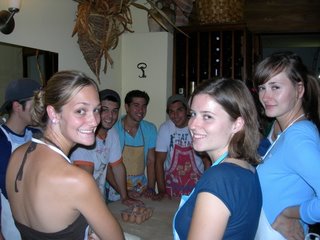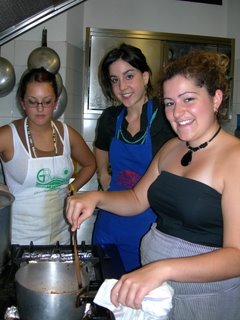The Secrets of Italian Cuisine – Sept. 27 & Oct. 4, 2006
 Everyone who has traveled to Italy marvels about the cuisine: the time-worn recipes, the obsession with freshness, and the culture and emotion that surround an Italian meal. Last Wednesday a group of us experienced “cucina italiana” from an insider’s perspective. We picked, prepared, and proudly ate our own creations at a celebrated osteria, or eatery, in the center of Florence. Our group met after classes and walked to the Oltrarno, the eclectic district on the other side of the Arno River that houses countless traditional artisan workshops, and family-run trattorie.
Everyone who has traveled to Italy marvels about the cuisine: the time-worn recipes, the obsession with freshness, and the culture and emotion that surround an Italian meal. Last Wednesday a group of us experienced “cucina italiana” from an insider’s perspective. We picked, prepared, and proudly ate our own creations at a celebrated osteria, or eatery, in the center of Florence. Our group met after classes and walked to the Oltrarno, the eclectic district on the other side of the Arno River that houses countless traditional artisan workshops, and family-run trattorie.  It was only 5:30, and we were in for a first-class, multiple-hour cooking workshop with Chef Daniela of Osteria Bene Vobis. Daniela is a Florentine woman who owns and operates this tiny restaurant on Via de’Serragli. The restaurant has only 15 tables, and holds no more than 50 people at capacity. The main room is long and narrow, similar to a wine cellar, and it is adorned with pyramids of wine and photos of historic Florence on the walls. Daniela welcomed us into her kitchen, which held no more than five of us at a time. Her old-world kitchen was reminiscent of an Italian grandmother’s kitchen when she’s cooking a celebratory meal for an extended family. But Chef Daniela didn’t waste a moment to chitchat; she immediately put us to work. Some of the group started chopping carrots, celery and zucchini for a vegetable sauce that would be used for homemade pasta. While working, Daniela stressed the importance of the order in which a good chef plans her meal. Those dishes that are time-consuming should be done first,
It was only 5:30, and we were in for a first-class, multiple-hour cooking workshop with Chef Daniela of Osteria Bene Vobis. Daniela is a Florentine woman who owns and operates this tiny restaurant on Via de’Serragli. The restaurant has only 15 tables, and holds no more than 50 people at capacity. The main room is long and narrow, similar to a wine cellar, and it is adorned with pyramids of wine and photos of historic Florence on the walls. Daniela welcomed us into her kitchen, which held no more than five of us at a time. Her old-world kitchen was reminiscent of an Italian grandmother’s kitchen when she’s cooking a celebratory meal for an extended family. But Chef Daniela didn’t waste a moment to chitchat; she immediately put us to work. Some of the group started chopping carrots, celery and zucchini for a vegetable sauce that would be used for homemade pasta. While working, Daniela stressed the importance of the order in which a good chef plans her meal. Those dishes that are time-consuming should be done first,  so that each course is served in a relaxed traditional Italian sequence; the pasta or soup, then second course, and finally, dessert. Following her advice, two of us then began to assemble the eggplant parmagiana that would become our second course, while a couple others started mixing the ingredients to make a typical cake; torta all’ananas (pineapple cake). While stirring, chopping and chatting continued, Daniela shared some of her expertise on Italian cuisine; how to choose the right ingredients, using the fruits and vegetables that are “in season” and which sauces compliment each pasta form. We moved into the dining room to start to work
so that each course is served in a relaxed traditional Italian sequence; the pasta or soup, then second course, and finally, dessert. Following her advice, two of us then began to assemble the eggplant parmagiana that would become our second course, while a couple others started mixing the ingredients to make a typical cake; torta all’ananas (pineapple cake). While stirring, chopping and chatting continued, Daniela shared some of her expertise on Italian cuisine; how to choose the right ingredients, using the fruits and vegetables that are “in season” and which sauces compliment each pasta form. We moved into the dining room to start to work  on our masterpiece, homemade pasta. On the evening’s menu was tagliatelle from “scratch’. This pasta is long and flat, similar to fettuccine, but thicker. A group mixed the ingredients, while the rest of us waited impatiently to roll the pasta dough and cut it into long slices. We prepared it with the rolling pin, using the traditional rolling method, and also passed it through a strange contraption attached to the table, the modern pasta maker. The pasta maker made the process faster, but you still had to be quite skilled to crank the handle while passing the dough through, and catching it on the way out of the maker. Everyone had their opportunity to try and master the pasta machine, and by the end we were all rather proficient. I looked at the clock and it was already seven, however, the labor-intensive pasta-making was finished.
on our masterpiece, homemade pasta. On the evening’s menu was tagliatelle from “scratch’. This pasta is long and flat, similar to fettuccine, but thicker. A group mixed the ingredients, while the rest of us waited impatiently to roll the pasta dough and cut it into long slices. We prepared it with the rolling pin, using the traditional rolling method, and also passed it through a strange contraption attached to the table, the modern pasta maker. The pasta maker made the process faster, but you still had to be quite skilled to crank the handle while passing the dough through, and catching it on the way out of the maker. Everyone had their opportunity to try and master the pasta machine, and by the end we were all rather proficient. I looked at the clock and it was already seven, however, the labor-intensive pasta-making was finished.  We were finally ready to cook it and start our feast. The table was re-set and all ten of us were ready to taste our hard labor. As we waited impatiently for the pasta to boil, we had a few minutes to gossip about of the cuisine of the region and trade other secrets of good eating we’d learned in Italy; the differences in olive oil, where to find the best cheeses, and now the best technique to roll homemade pasta. In the end, the plates were served by Daniela in traditional order, the tagliatelle first, next parmagiana, and don’t forget, the torta. We laughed at each other’s cooking stories and contributions, while savoring our success. As we were eating I realized that this is the true gift from experiencing “cucina italiana’; an evening with good friends, fascinating conversation and a healthy homemade meal.
We were finally ready to cook it and start our feast. The table was re-set and all ten of us were ready to taste our hard labor. As we waited impatiently for the pasta to boil, we had a few minutes to gossip about of the cuisine of the region and trade other secrets of good eating we’d learned in Italy; the differences in olive oil, where to find the best cheeses, and now the best technique to roll homemade pasta. In the end, the plates were served by Daniela in traditional order, the tagliatelle first, next parmagiana, and don’t forget, the torta. We laughed at each other’s cooking stories and contributions, while savoring our success. As we were eating I realized that this is the true gift from experiencing “cucina italiana’; an evening with good friends, fascinating conversation and a healthy homemade meal.
 Everyone who has traveled to Italy marvels about the cuisine: the time-worn recipes, the obsession with freshness, and the culture and emotion that surround an Italian meal. Last Wednesday a group of us experienced “cucina italiana” from an insider’s perspective. We picked, prepared, and proudly ate our own creations at a celebrated osteria, or eatery, in the center of Florence. Our group met after classes and walked to the Oltrarno, the eclectic district on the other side of the Arno River that houses countless traditional artisan workshops, and family-run trattorie.
Everyone who has traveled to Italy marvels about the cuisine: the time-worn recipes, the obsession with freshness, and the culture and emotion that surround an Italian meal. Last Wednesday a group of us experienced “cucina italiana” from an insider’s perspective. We picked, prepared, and proudly ate our own creations at a celebrated osteria, or eatery, in the center of Florence. Our group met after classes and walked to the Oltrarno, the eclectic district on the other side of the Arno River that houses countless traditional artisan workshops, and family-run trattorie.  It was only 5:30, and we were in for a first-class, multiple-hour cooking workshop with Chef Daniela of Osteria Bene Vobis. Daniela is a Florentine woman who owns and operates this tiny restaurant on Via de’Serragli. The restaurant has only 15 tables, and holds no more than 50 people at capacity. The main room is long and narrow, similar to a wine cellar, and it is adorned with pyramids of wine and photos of historic Florence on the walls. Daniela welcomed us into her kitchen, which held no more than five of us at a time. Her old-world kitchen was reminiscent of an Italian grandmother’s kitchen when she’s cooking a celebratory meal for an extended family. But Chef Daniela didn’t waste a moment to chitchat; she immediately put us to work. Some of the group started chopping carrots, celery and zucchini for a vegetable sauce that would be used for homemade pasta. While working, Daniela stressed the importance of the order in which a good chef plans her meal. Those dishes that are time-consuming should be done first,
It was only 5:30, and we were in for a first-class, multiple-hour cooking workshop with Chef Daniela of Osteria Bene Vobis. Daniela is a Florentine woman who owns and operates this tiny restaurant on Via de’Serragli. The restaurant has only 15 tables, and holds no more than 50 people at capacity. The main room is long and narrow, similar to a wine cellar, and it is adorned with pyramids of wine and photos of historic Florence on the walls. Daniela welcomed us into her kitchen, which held no more than five of us at a time. Her old-world kitchen was reminiscent of an Italian grandmother’s kitchen when she’s cooking a celebratory meal for an extended family. But Chef Daniela didn’t waste a moment to chitchat; she immediately put us to work. Some of the group started chopping carrots, celery and zucchini for a vegetable sauce that would be used for homemade pasta. While working, Daniela stressed the importance of the order in which a good chef plans her meal. Those dishes that are time-consuming should be done first,  so that each course is served in a relaxed traditional Italian sequence; the pasta or soup, then second course, and finally, dessert. Following her advice, two of us then began to assemble the eggplant parmagiana that would become our second course, while a couple others started mixing the ingredients to make a typical cake; torta all’ananas (pineapple cake). While stirring, chopping and chatting continued, Daniela shared some of her expertise on Italian cuisine; how to choose the right ingredients, using the fruits and vegetables that are “in season” and which sauces compliment each pasta form. We moved into the dining room to start to work
so that each course is served in a relaxed traditional Italian sequence; the pasta or soup, then second course, and finally, dessert. Following her advice, two of us then began to assemble the eggplant parmagiana that would become our second course, while a couple others started mixing the ingredients to make a typical cake; torta all’ananas (pineapple cake). While stirring, chopping and chatting continued, Daniela shared some of her expertise on Italian cuisine; how to choose the right ingredients, using the fruits and vegetables that are “in season” and which sauces compliment each pasta form. We moved into the dining room to start to work  on our masterpiece, homemade pasta. On the evening’s menu was tagliatelle from “scratch’. This pasta is long and flat, similar to fettuccine, but thicker. A group mixed the ingredients, while the rest of us waited impatiently to roll the pasta dough and cut it into long slices. We prepared it with the rolling pin, using the traditional rolling method, and also passed it through a strange contraption attached to the table, the modern pasta maker. The pasta maker made the process faster, but you still had to be quite skilled to crank the handle while passing the dough through, and catching it on the way out of the maker. Everyone had their opportunity to try and master the pasta machine, and by the end we were all rather proficient. I looked at the clock and it was already seven, however, the labor-intensive pasta-making was finished.
on our masterpiece, homemade pasta. On the evening’s menu was tagliatelle from “scratch’. This pasta is long and flat, similar to fettuccine, but thicker. A group mixed the ingredients, while the rest of us waited impatiently to roll the pasta dough and cut it into long slices. We prepared it with the rolling pin, using the traditional rolling method, and also passed it through a strange contraption attached to the table, the modern pasta maker. The pasta maker made the process faster, but you still had to be quite skilled to crank the handle while passing the dough through, and catching it on the way out of the maker. Everyone had their opportunity to try and master the pasta machine, and by the end we were all rather proficient. I looked at the clock and it was already seven, however, the labor-intensive pasta-making was finished.  We were finally ready to cook it and start our feast. The table was re-set and all ten of us were ready to taste our hard labor. As we waited impatiently for the pasta to boil, we had a few minutes to gossip about of the cuisine of the region and trade other secrets of good eating we’d learned in Italy; the differences in olive oil, where to find the best cheeses, and now the best technique to roll homemade pasta. In the end, the plates were served by Daniela in traditional order, the tagliatelle first, next parmagiana, and don’t forget, the torta. We laughed at each other’s cooking stories and contributions, while savoring our success. As we were eating I realized that this is the true gift from experiencing “cucina italiana’; an evening with good friends, fascinating conversation and a healthy homemade meal.
We were finally ready to cook it and start our feast. The table was re-set and all ten of us were ready to taste our hard labor. As we waited impatiently for the pasta to boil, we had a few minutes to gossip about of the cuisine of the region and trade other secrets of good eating we’d learned in Italy; the differences in olive oil, where to find the best cheeses, and now the best technique to roll homemade pasta. In the end, the plates were served by Daniela in traditional order, the tagliatelle first, next parmagiana, and don’t forget, the torta. We laughed at each other’s cooking stories and contributions, while savoring our success. As we were eating I realized that this is the true gift from experiencing “cucina italiana’; an evening with good friends, fascinating conversation and a healthy homemade meal.
<< Home